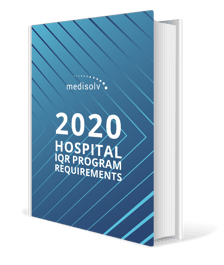The History of Quality Reporting
By Erin Heilman March 24, 2017 Industry Trends

A Succinct Summary of the Major Characters and Events of Quality in Healthcare
 Ahem, settle down class. Take your seats.
Ahem, settle down class. Take your seats.
Yes, very good.
Today, we are learning about the history of healthcare quality efforts. Let’s start with some notable historical figures. Please note, this is not an exhaustive list.
Let us begin.
Notable Historical Figures
Ignaz Semmelweis (July 1, 1818 – August 13, 1865)
In 1847, Ignaz Semmelweis, a Hungarian physician, proposes that the practice of washing hands drastically cuts the incidences of childbed fever, which was common at the time and often fatal. It didn’t work out so well for Ignaz though. Turns out his colleagues vehemently disagreed with his position and threw him into an asylum to boot.
 And thus, our story of healthcare quality begins.
And thus, our story of healthcare quality begins.
Florence Nightingale (May 12, 1820 – August 13, 1910)
Florence Nightingale, an English nurse, was known as the founder of modern nursing. Florence was also instrumental in bringing issues of sanitation to the notice of members of Parliament. Through her research, she demonstrated that bad drainage, contaminated water, overcrowding and poor ventilation were causing a high death rate for the British army in the Crimean War.
 To this day, the conclusion of National Nurses Week is celebrated on her birthday.
To this day, the conclusion of National Nurses Week is celebrated on her birthday.
Ernest Codman (December 30, 1869 – November 23, 1940)
An advocate of hospital reform, Ernest Codman, is widely known as the founder of outcomes management in patient care. He was the first doctor to document the patient fully from demographic data, to diagnosis, treatments and outcomes. He would document the steps of the patient on “End Result Cards.” He would then keep up with these patients for at least one year; a practice he called the “End Result Theory.” He believed firmly that tracking of patient outcomes would help discover areas of improving future patient care.
Ernest also helped found the America College of Surgeons and the Hospital Standardization Program, which eventually transformed into The Joint Commission.
 I believe you are familiar with them. Yes?
I believe you are familiar with them. Yes?
Avedis Donabedian (January 7, 1919 – November 9, 2000)
Avedis was a physician and is widely regarded as the founder of Quality in healthcare. He is most famous for his paper entitled, “Evaluating the Quality of Medical Care” that was published in 1966 and is still widely cited and read today. He was a prolific researcher and writer who primarily focused on defining quality in health systems and proposing models for measurement.
 Fun fact. He was also a poet.
Fun fact. He was also a poet.
“Systems awareness and systems design are important for health professionals, but are not enough. They are enabling mechanisms only. It is the ethical dimension of individuals that is essential to a system’s success. Ultimately, the secret of quality is love.”
-Avedis Donabedian
 Now, let us move on to the next portion of our lesson, a timeline of major events in the history of healthcare quality.
Now, let us move on to the next portion of our lesson, a timeline of major events in the history of healthcare quality.
Major Health care Quality Events Timeline
1965: CMS is established.
President Lyndon B. Johnson signed into law the bill that led to the formation of Medicare and Medicaid and the Centers for Medicare and Medicaid (CMS).
1965: Utilization Review Committees are created.
Anticipating the need for oversight of these new programs Congress established Utilization Review Committees, which were tasked with identifying if hospitals and doctors were providing appropriate clinical care. These committees were largely viewed as ineffective and did little to identify ways to improve care.
1972: Experimental Medical Care Review Organizations are created.
Experimental Medical Care Review Organizations were created to combat the ineffectiveness of the committees before them. They were given similar authority but were able to develop projects and models that were a direct result of their findings.
1972: Professional Standards Review Organizations (PSROs) are established.
Building off the example of those organizations, Congress established Professional Standards Review Organizations (PSROs) who were responsible for creating a network of nonprofit, physician-run organizations that assessed whether hospitals and physicians were providing a high quality of care. This group however, was considered unsuccessful in that task.
1983: Peer Review Organizations (PROs) replace the PSROs.
Peer Review Organizations (PROs) replace the PSROs. This group was successful largely because they had the authority to implement solutions based on findings, unlike the previous models.
1992: Quality Improvement Initiative is proposed.
The Quality Improvement Initiative is proposed by the Healthcare Financing Administration (HCFA) which attempted to make algorithms of patient care based on data from quality findings.
1994: National Surgery Quality Improvement Project (NSQIP) is developed.
The National Surgery Quality Improvement Project (NSQIP) is developed in the Veterans Affairs’ (VA) system by Congress to address higher surgical mortality in VA hospitals. Methodologies from the findings were later applied to non-VA hospitals.
2003: Surgical Care Improvement Program (SCIP) is established.
The Surgical Care Improvement Program (SCIP) is established whose goal was to reduce surgical complications and mortality rates. At first participation was voluntary, but later transitioned to a mandatory publicly reported system.
2003: The Inpatient Quality Reporting (IQR) program is established.
The Inpatient Quality Reporting (IQR) program is established, which widely expands the requirements for public reporting of quality data. This program which used a series of incentives and later penalties that affected Medicare payments, intends to improve the quality of care and provide patients insight on the quality of care at a hospital.
2006: Physician Quality Reporting Initiative (PQRI) is created.
Creation of the Physician Quality Reporting Initiative (PQRI), a healthcare quality improvement incentive program is created by CMS. This program is used to incentivize providers to report quality data to CMS.
2008: Congress sets aside $30 billion to get hospitals connected online.
Congress passes the economy stimulus package to assist in economic recovery, setting aside $30 billion to help get healthcare systems connected via Electronic Health Records (EHR) technology.
2010: The Patient Protection and Accountable Care Act (PPACA) is signed into law.
The law was amended by the Health Care and Education Reconciliation Act on March 30, 2010. The name “Affordable Care Act” is usually used to refer to the final, amended version of the law. (It’s sometimes known as “PPACA,” “ACA,” or “Obamacare.”)
2010: Meaningful Use is enacted.
The Meaningful Use requirements become effective as a part of the Health Information Technology for Economic and Clinical Health (HITECH) Act.
2011: PQRI transitions to the Physician Quality Reporting System (PQRS).
PQRI transitions to the Physician Quality Reporting System (PQRS). The program was also an incentive program which later transitioned to a penalty program.
2012: The Value-Based Modifier program is enacted.
The Value-Based Modifier program becomes effective.
2015: MACRA is passed by Congress.
Medicare Access & CHIP Reauthorization Act is passed by Congress. This bill is designed for Medicare payment reform which aims to lower healthcare costs and improve the quality of patient care.
2016: Electronic submission of quality measures is required for the IQR program.
Electronic reporting of quality measures is required for submission to the IQR program for the first time.
2016: The Quality Payment Program (QPP) is established.
The Quality Payment Program (QPP) is established as a part of the MACRA legislation. The Merit-based Incentive Payment System (MIPS) reporting option combines PQRS, Meaningful Use and the Value-Based Modifier programs into just one program.
2017: All major regulatory reporting programs require electronic submission of quality measures.
All major regulatory reporting programs require electronic submission of quality measures. Programs include the IQR program, The Joint Commission ORYX Accreditation program and the Quality Payment Program.
 And finally, a study of acronyms
And finally, a study of acronyms
Instrumental Quality Advocacy Groups and Their Formation Years
1847: The American Medical Association (AMA)
1898: The American Hospital Association (AHA)
1928: American Health Information Management Association (AHIMA)
1951: The Joint Commission on Accreditation of Hospitals (Later known as The Joint Commission.)
1961: Healthcare Information and Management Systems Society (HIMSS)
1965: The Centers for Medicare & Medicaid
1970: Institute of Medicine (IOM)
1989: Agency for Healthcare Research and Quality (AHRQ)
1990: National Committee for Quality Assurance (NCQA)
1991: Institute for Healthcare Improvement (IHI)
1999: The National Quality Forum (NQF)
1999: Medisolv is established! (No acronym needed.)
2004: Office of the National Coordinator of Health Information Technology (ONC)
2010: Patient-Centered Outcomes Research Institute (PCORI)
 Well, I certainly hope you learned something today. Remember that this quality journey you are on may seem frustrating at times, but to get to where you sit this very day, there is a long history of pioneers who came before you and have pushed for reforms to the quality of care. Each big or little push makes our patients, hospitals and providers safer. And you are a part of this journey. Your contributions in your hospital or practice setting continue to fill the pages of this History of Quality reporting novel we write together.
Well, I certainly hope you learned something today. Remember that this quality journey you are on may seem frustrating at times, but to get to where you sit this very day, there is a long history of pioneers who came before you and have pushed for reforms to the quality of care. Each big or little push makes our patients, hospitals and providers safer. And you are a part of this journey. Your contributions in your hospital or practice setting continue to fill the pages of this History of Quality reporting novel we write together.
And for my brown-nosing, front-seat sitting, teacher pets, I’ve provided you with extra homework assignments for you to peruse or complete at your leisure.
Further Reading
- 7 Hospital IQR Program Requirements for 2019
- 2019 Joint Commission ORYX® Requirements
- MIPS Year Three: 14 Things to Know
[E-BOOK DOWNLOAD]
2020 hospital iQR requirements
Ensure a smooth and stress-free submission to the Hospital Inpatient Quality Reporting (IQR) program. Download the 2020 IQR eBook, which includes all you need to know to successfully complete the program in 2020.
This guide includes:
- Requirements for each part of the program
- Submission method details
- A measure removal guide for 2019-2021
- 2020 deadlines

|






Add a comment